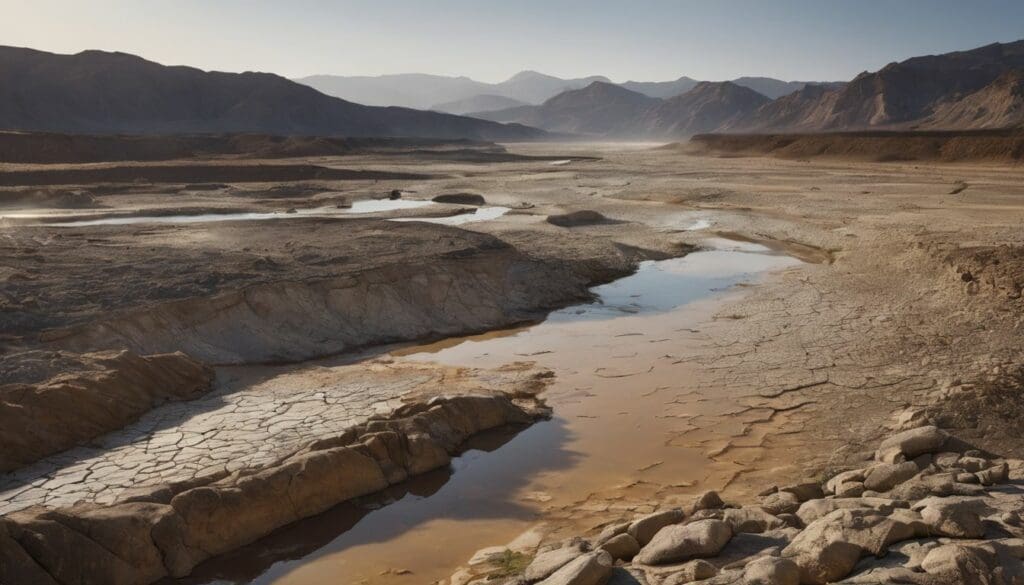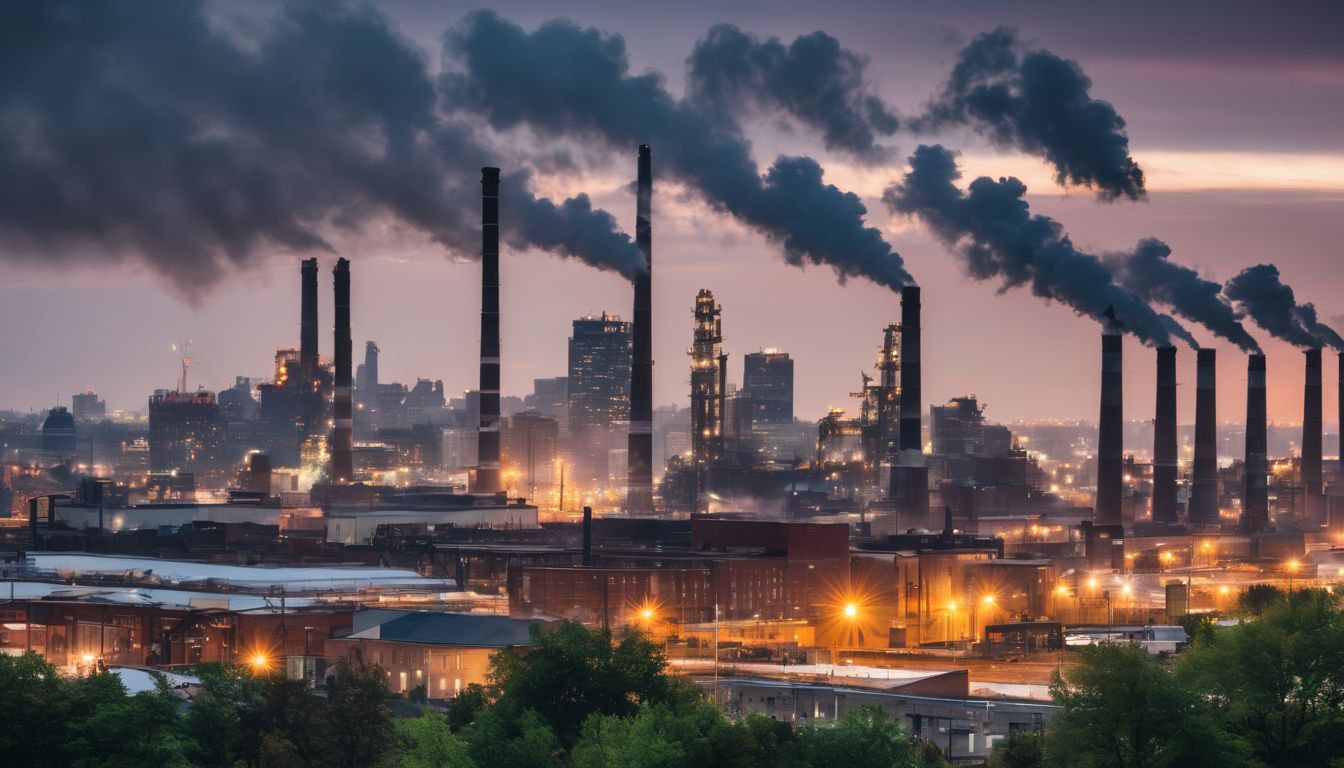Water is becoming harder to find in many places around the world. Did you know that climate change affects how and where we get our water? This blog will show you the connection between a warming planet and less drinking water.
Let’s uncover this ripple effect together.
Key Takeaways
- Climate change is causing more extreme weather like heavy storms and prolonged droughts, which leads to unpredictable water supplies and higher pollution levels in rivers and streams.
- Rising temperatures from global warming are resulting in drier conditions that make scarce water even harder to find, affecting everything from drinking water to farming and wildlife.
- As the world gets warmer, water quality suffers because of increased algal blooms and lower oxygen levels that harm aquatic life; this also poses risks for human health due to possible contamination of drinking water sources.
- To fight back against the negative effects on our water caused by a changing climate, we need smart management strategies including strict pollution controls and community efforts geared towards conservation.
- Economic differences mean some people have less protection against the impacts of climate change on water resources, highlighting the need for fair policies that help everyone access clean, safe water.
The Link Between Water Scarcity and Climate Change
Climate change disrupts weather patterns and leads to extreme events, resulting in water scarcity, unpredictability, and pollution. Diminished flows in rivers and streams can also increase harmful pollutant concentrations.
Climate change is disrupting weather patterns
Rising global temperatures are throwing natural weather patterns off balance. This shift leads to more frequent and intense droughts, altering the rhythm of precipitation that ecosystems and communities rely on.
Fluctuating rainfall can cause rivers and lakes to either swell dangerously or shrink, leaving less water for drinking, agriculture, and sustaining wildlife.
As dry regions become drier and wet areas get inundated with rain, the once predictable water cycle faces disruption on a massive scale. These changes not only affect the availability of fresh water but also threaten its quality.
When severe weather strikes—whether scorching heatwaves or devastating storms—it raises the risk of pushing pollutants into our water resources, complicating efforts to ensure safe drinking water supplies and protect aquatic life.
With each erratic shift in climate variability comes a new challenge in managing our precious water security. Sustainable water management practices have never been more critical in adapting to these unpredictable changes caused by global warming.
As environmental degradation continues to compound these issues, it’s imperative that we act swiftly to mitigate this growing crisis before it escalates further into widespread water stress across different regions around the globe.
Extreme weather events are making water more scarce, unpredictable, and polluted
Extreme weather events, such as intense storms and prolonged droughts, are reducing water availability. This leads to unpredictable and scarce water resources. Furthermore, these events contribute to the pollution of water sources due to increased runoff carrying contaminants into rivers and streams.
As a result, climate change is exacerbating the already critical issue of water scarcity, creating significant challenges for both ecosystems and human communities.
Diminished flows in rivers and streams can increase the concentration of harmful pollutants, affecting both wildlife and human health. The effects of extreme weather on the hydrological cycle lead to a greater risk of water contamination as well as an overall decrease in reliable access to clean drinking water.
Diminished flows in rivers and streams can increase concentration of harmful pollutants
Diminished flows in rivers and streams heighten the risk of harmful pollutants accumulating, posing a threat to aquatic ecosystems and water quality. Reduced water levels can concentrate contaminants, including pesticides and industrial waste, making it imperative to address the impact of diminished flows on water pollution.
Additionally, heightened pollutant concentrations can harm aquatic life and elevate health risks for communities relying on these water sources.
Furthermore, as water scarcity intensifies due to climate change, maintaining healthy river and stream flows becomes crucial in preventing pollution buildup. Addressing this issue is pivotal in safeguarding freshwater resources against contamination while ensuring sustainability for future generations.
Impacts of Climate Change on Water Availability
Severe weather events like droughts and floods are becoming more frequent due to climate change, leading to drier conditions and water scarcity. Warmer temperatures can also affect the quality of available water sources.
More severe weather events
Extreme weather events, such as hurricanes, floods, and droughts, are becoming more frequent due to climate change. These events lead to disruptions in water availability and quality.
For example, heavy rainfall can overwhelm sewage systems leading to contamination of water sources, while prolonged dry spells can deplete groundwater reserves and reduce the flow of rivers and streams.
Rising global temperatures exacerbate these extreme weather patterns by intensifying evaporation rates from water bodies. This makes it harder for communities to access clean drinking water and necessitates the implementation of sustainable solutions like rainwater harvesting and efficient irrigation techniques.
Drier conditions leading to scarcity
Drier conditions result in water scarcity, impacting availability for drinking, irrigation, and industry. With less rainfall, reservoirs and aquifers reduce capacity, affecting communities’ access to clean water.
Warmer temperatures lead to increased evaporation that further exacerbates the problem. Climate change disrupts traditional precipitation patterns, causing prolonged droughts in some regions, intensifying pressures on already limited water supplies.
Diminishing supplies affect agriculture productivity and food security while also escalating competition for available resources. Simultaneously, drier conditions contribute to an increase in wildfires which can further damage ecosystems crucial for maintaining healthy water cycles.
Warmer temperatures affecting water quality
Rising global temperatures are impacting the quality of our water. As temperatures increase, it can lead to harmful algal blooms in lakes and reservoirs. These blooms are detrimental to both aquatic life and human health, releasing toxins into the water which can contaminate drinking supplies.
Warmer temperatures also diminish oxygen levels in water, making it difficult for fish and other aquatic organisms to survive. Additionally, higher temperatures exacerbate the growth of bacteria and viruses in water sources, further compromising its quality.
This underscores the urgency of addressing climate change to safeguard our precious water resources for future generations.
Water Scarcity and Pollution
Climate change increasing the risk of water contamination and the importance of reducing water pollution is crucial for maintaining a sustainable environment. Read more about the impact of climate change on water scarcity and how we can address this critical issue.
Climate change increasing the risk of water contamination
Climate change heightens the risk of water contamination. Extreme weather events, intensified by climate change, contribute to increased runoff and overflows of harmful pollutants into water sources.
Warmer temperatures can lead to algal blooms, affecting water quality and posing a threat to aquatic ecosystems. The rise in temperature also accelerates chemical reactions that can increase the concentration of certain toxins in freshwater bodies, exacerbating the risk of contamination.
Efforts to mitigate climate change are paramount in safeguarding water quality and availability. Emphasising on reducing carbon emissions and implementing sustainable practices plays a crucial role in protecting our precious water resources from further pollution.
The importance of reducing water pollution
Reducing water pollution is crucial for safeguarding our environment and ensuring a sustainable water supply. By implementing effective pollution control measures, we can protect freshwater sources from contaminants and preserve the health of ecosystems.
Educating communities about responsible waste disposal and promoting eco-friendly practices are essential steps towards reducing water pollution.
Implementing stringent regulations on industrial discharges and agricultural runoff is vital in preventing further contamination of our waterways. Engaging in conservation efforts to preserve natural habitats also plays a significant role in reducing the impact of pollutants on aquatic ecosystems.
Projects addressing water pollution
Climate-resilient infrastructure is being developed to treat and manage water pollution.
Addressing the Discrepancy Between Physical Water Scarcity and Insecurity
Socioeconomic vulnerabilities and governance gaps exacerbate the impact of physical water scarcity, highlighting the importance of effective water management to address the issue. By addressing these discrepancies, we can work towards ensuring water security for all.
Socioeconomic vulnerabilities
Socioeconomic vulnerabilities can exacerbate the impact of water scarcity and climate change. Communities with lower incomes often struggle to access clean water and are more vulnerable to extreme weather events.
Lack of resources can hinder their ability to adapt to changing environmental conditions, increasing the risk of water-related health issues.
In addition, marginalised communities may face challenges in accessing information and resources for adapting to water scarcity. It is crucial for policymakers and organisations to address these disparities by implementing inclusive strategies that consider the unique needs of socioeconomically vulnerable populations.
Governance gaps
Water scarcity and climate change represent a complex web of socio-economic vulnerabilities and governance gaps. These gaps can exacerbate the challenges of water management, jeopardising the resilience of communities and ecosystems.
Effective governance, policies, and regulations are essential to address these discrepancies, ensuring equitable access to clean water while safeguarding it for future generations.
Without proactive measures to bridge these gaps, vulnerable populations face heightened risks from the impacts of water insecurity.
To tackle this issue comprehensively, collaborative efforts between policymakers, communities, and environmental organisations are imperative. Heightened awareness among stakeholders about the implications of governance gaps is crucial in steering action towards sustainable water management practices.
Importance of effective water management
From addressing governance gaps, it becomes evident that effective water management is crucial in mitigating the impacts of water scarcity and climate change. Developing sustainable strategies for managing water resources is essential to ensure their availability for future generations.
Implementing efficient irrigation techniques, promoting responsible agricultural practices, and investing in modern infrastructure are all integral aspects of effective water management.
Moreover, raising awareness about water conservation and encouraging individual responsibility in reducing water consumption play a pivotal role in safeguarding our precious natural resource.
Conclusion
In conclusion, climate change has a direct impact on water scarcity. Extreme weather events disrupt weather patterns and result in unpredictable and polluted water sources. Warmer temperatures affect the quality of water available for consumption.
Addressing these issues is crucial to ensure sustainable management of water resources. Effective water management, reducing pollution, and addressing socioeconomic vulnerabilities are essential in mitigating the impacts of climate change on water scarcity.
FAQs
1. What is the link between climate change and water scarcity?
Climate change causes extreme weather, which can lead to both droughts and floods—making fresh water scarce in many places around the world.
2. How does water scarcity affect us?
Water scarcity means there’s not enough clean water for everyone, leading to struggles with farming, drinking supplies, and keeping our environment healthy.
3. Can we do anything to fix the water crisis linked with climate change?
Yes, by cutting down on greenhouse gases and using water wisely, we can help fight climate change and manage our precious water resources better.
4. Will it get worse if we don’t take action on climate change concerning water scarcity?
If we don’t act against climate change now, it’s likely that more people will experience a shortage of clean water in the future due to worsening conditions.





